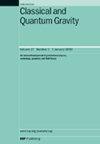Quantum geometry of the light cone: Fock representation and spectrum of radiated power
IF 3.7
3区 物理与天体物理
Q2 ASTRONOMY & ASTROPHYSICS
引用次数: 0
Abstract
Starting from the symplectic potential for the γ-Palatini–Holst action on a null hypersurface, we identify an auxiliary conformal field theory (CFT), which carries a representation of the constraint algebra of general relativity on a null surface. The radiative data, which is encoded into the shear of each null generator, is mapped into an current algebra on each light ray. We study the resulting quantum theory for both bosonic and fermionic representations. In the fermionic representation, the central charge on each null ray is positive, for bosons it is negative. A negative central charge implies a non-unitary CFT, which has negative norm states. In the model, there is a natural Casimir. For the bosonic representations, the Casimir can have either sign. For the fermionic representations, the Casimir is always greater or equal to zero. To exclude negative norm states, we restrict ourselves to the fermionic case. To understand the physical implications of this restriction, we express the Casimir in terms of the geometric data. In this way, the positivity bound on the Casimir translates into an upper bound for the shear of each null generator. In the model, this bound must be satisfied for all three-dimensional null hypersurfaces. This in turn suggests to apply it to an entire null foliation in an asymptotically flat spacetime. In this way, we obtain a bound on the radiated power of gravitational waves in the model.光锥的量子几何:Fock表示和辐射功率的光谱
从零曲面上γ-Palatini-Holst作用的辛势出发,我们确定了一个辅助共形场论(CFT),它包含了零曲面上广义相对论约束代数的表示。辐射数据被编码到每个零发生器的剪切中,并被映射到每个光线上的当前代数中。我们研究了玻色子和费米子表示的量子理论。在费米子表示中,每个零射线的中心电荷是正的,而对玻色子来说是负的。中心电荷为负意味着具有负范数状态的非酉CFT。在这个模型中,有一个天然的卡西米尔。对于玻色子表示,卡西米尔可以有任意一种符号。对于费米子表示,卡西米尔总是大于或等于零。为了排除负模态,我们将自己限制在费米子的情况下。为了理解这一限制的物理含义,我们用几何数据来表示卡西米尔。这样,卡西米尔曲线上的正边界转化为每个零发生器剪切的上界。在模型中,对于所有三维零超曲面都必须满足这个界。这反过来又建议将其应用于渐近平坦时空中的整个零叶理。这样,我们就得到了模型中引力波辐射功率的一个界。
本文章由计算机程序翻译,如有差异,请以英文原文为准。
求助全文
约1分钟内获得全文
求助全文
来源期刊

Classical and Quantum Gravity
物理-天文与天体物理
CiteScore
7.00
自引率
8.60%
发文量
301
审稿时长
2-4 weeks
期刊介绍:
Classical and Quantum Gravity is an established journal for physicists, mathematicians and cosmologists in the fields of gravitation and the theory of spacetime. The journal is now the acknowledged world leader in classical relativity and all areas of quantum gravity.
 求助内容:
求助内容: 应助结果提醒方式:
应助结果提醒方式:


